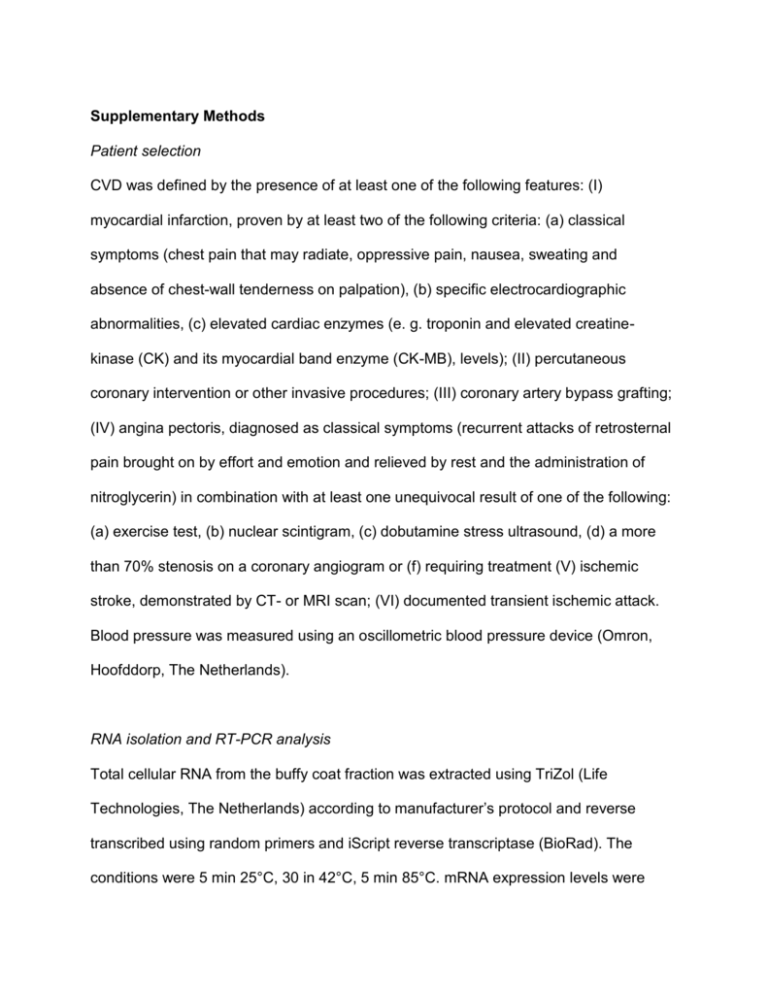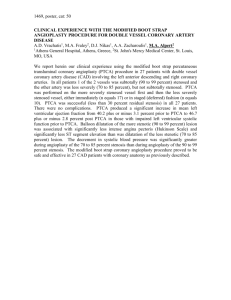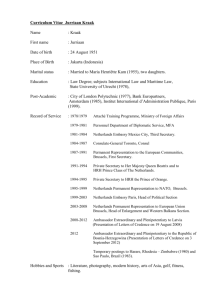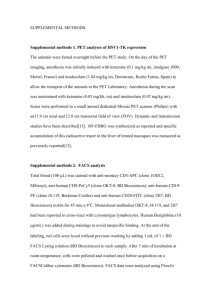Supplementary Methods Patient selection CVD was defined by the
advertisement

Supplementary Methods Patient selection CVD was defined by the presence of at least one of the following features: (I) myocardial infarction, proven by at least two of the following criteria: (a) classical symptoms (chest pain that may radiate, oppressive pain, nausea, sweating and absence of chest-wall tenderness on palpation), (b) specific electrocardiographic abnormalities, (c) elevated cardiac enzymes (e. g. troponin and elevated creatinekinase (CK) and its myocardial band enzyme (CK-MB), levels); (II) percutaneous coronary intervention or other invasive procedures; (III) coronary artery bypass grafting; (IV) angina pectoris, diagnosed as classical symptoms (recurrent attacks of retrosternal pain brought on by effort and emotion and relieved by rest and the administration of nitroglycerin) in combination with at least one unequivocal result of one of the following: (a) exercise test, (b) nuclear scintigram, (c) dobutamine stress ultrasound, (d) a more than 70% stenosis on a coronary angiogram or (f) requiring treatment (V) ischemic stroke, demonstrated by CT- or MRI scan; (VI) documented transient ischemic attack. Blood pressure was measured using an oscillometric blood pressure device (Omron, Hoofddorp, The Netherlands). RNA isolation and RT-PCR analysis Total cellular RNA from the buffy coat fraction was extracted using TriZol (Life Technologies, The Netherlands) according to manufacturer’s protocol and reverse transcribed using random primers and iScript reverse transcriptase (BioRad). The conditions were 5 min 25°C, 30 in 42°C, 5 min 85°C. mRNA expression levels were measured using SensiFast Sybr Green master mix (GE-Biotech) on CFX386 system (BioRab, the Netherlands). Primers were designed using Primer3 software and were exon-intron boundary crossing (Table S1). RT-PCR conditions were: 10 min 95°C followed by 40 cycles 15’ 95°C 30’ 60°C and finally a melt reaction going from 65°-95°C in 5’ per grade. Gene expression was calculated using the 2ΔΔCt method using 36B4 as reference gene. Immunohistochemistry Sections were fixed in 4% paraformaldehyde and subsequently embedded in paraffin. For immunostaining, paraffin sections were deparaffinised before endogenous peroxidase quenching. After blocking with Ultra V Block (Thermo Fischer Scientific, Fremont, CA, USA) slides were incubated with anti-MCF2L 1:250 (rabbit polyclonal antiMCF2L, WH0023263M1, Sigma, Munich, Germany) overnight at 4ºC. Staining was performed with anti-rabbit Horse Radish Peroxidase (HRP)-labelled IgG (ImmunoLogic, Duiven, The Netherlands) followed by Bright DAB+ visualization (ImmunoLogic, Duiven, The Netherlands). Counterstaining was performed using hematoxylin and slides were cover-slipped with VectaMount (Vector Laboratories, Burlingname, CA, USA). Positive controls consisted of samples of human tonsil. Negative controls consisted of experimental tissues stained without the addition of primary antibodies following the same protocol. Microscopy pictures were analyzed using Adobe Photoshop CS4. To explore cellular localization of MCF2L in human atherosclerotic lesions the sequential alkaline phosphatase (AP) double staining method was used as described elsewhere [1]. MCF2L was stained in combination with either smooth muscle cell α-actin (SMA) (1:500; mouse 1A4 antibody, DAKO, Glostrup, Denmark), macrophage CD68 (1:100; mouse monoclonal anti human CD68 PG-M1, DAKO, Heverlee, Belgium), endothelial cell CD34 (1:1000; mouse anti human CD34Q, Bend10, ThermoFischer Scientific, Waltham, MA, USA), antigen presenting cells (CD11c; 1:50; mouse monoclonal 5D11, Monosan, Uden, The Netherlands), CD8 lymphocytes (1:50; mouse monoclonal anti-human CD8, CD8/144B, DAKO, Heverlee, Belgium) and rabbit anti human CD3 (1:5000;, IgG monoclonal SP7, ThermoFisher Scientific). Visualization was performed with vector blue (Vector Laboratories) for MCF2L and vector red (Vector Laboratories) for SMA, CD68, CD34, CD3, CDC11c and CD8 and cover slipped. Figure S1: The results of linkage analysis using Allegro software. Figure S2: mRNA expression of MCF2L, RAC1 and RHOA in total circulating white blood cells in 4 heterozygous carriers of the MCF2L c.2066A>G; p.(Asp689Gly) variant and one non-carrier relative. RNA expression was analyzed in three white blood cell RNA fractions per person. MCF2L expression was significantly decreased (P<0.05) in carriers of the variant. P<0.05 0.5 0.5 rel to 36B4 0.4 rel to 36B4 0.4 0.3 0.2 0.2 0.1 0.1 0.0 0.0 MCF2LAsp689 MCF2LGly689 MCF2LAsp689 MCF2LGly689 0.6 rel to 36B4 0.3 0.4 0.2 0.0 MCF2LAsp689 MCF2LGly689 Figure S3: Specifity of immunostaining of MCF2L. A. Single staining of MCF2L (brown) in control tonsil tissue. B. Negative control in tonsil tissue using only the secondary antibody. A B Table S1: Clinical characteristics of the relatives. Patient Sex Type of CVD Age CVD Medication MCF2L c.2066A>G; p.(Asp689Gly) Hyperte nsion (years) Smoking BMI (kg/m2) I-1 F None N/A None No No Yes 23 II:3 F None N/A None No No No 22 II:1 F PTCA 62 Lipitor 40 mg Yes No No 22 II:2 M AP 46 Inegy 40 mg Yes No Yes 25 II:4† M AMI 43 Lipitor 40 mg Yes No No 23 II:5 M CABG 40 Lipitor 20 mg Yes No Yes 26 II:6 F AMI/ PTCA 39 Zocor 20 mg Yes No No 24 PTCA = Percutaneous Transluminal Coronary Angioplasty; AP = Angina Pectoris; AMI = Acute Myocardial Infarction; CABG = coronary artery bypass surgery; BMI = body mass index (kg/cm2). † = index case. Subjects were considered smokers if they were current smokers or when they quitted smoking within the last 5 years. Hypertension was defined as a systolic blood pressure > 140 mmHg and/or diastolic blood pressure > 80 mmHg or the use of anti-hypertensive lowering drugs. Diabetes mellitus was defined as fasting plasma glucose ≥ 7.0 mmol/l or 2h plasma glucose ≥ 11.1 mmol/l as defined by the World Health Organization (WHO). Tabel S2: Linkage intervals with LODscore > -2 (NCBI137/hg19). Chr# Start SNP END Chr7 64406438 rs10949950 65357776 Chr7 66689728 rs11761805 67026320 Chr7 117378355 rs739798 132945754 Chr9 136927656 rs1076148 141213431 Chr11 123289850 rs2156443 131697483 Chr13 112349868 rs9560166 113839747 Chr14 0 start 20709688 Chr17 64816464 rs4791032 65343997 Chr18 429354 rs17564131 4780620 Chr20 2340973 rs6082889 9378671 Chr21 43448796 rs220229 44715784 Chr22 0 start 17254399 SNP rs35850374 rs4576304 rs10215367 End rs11603321 rs515863 rs7156806 rs9904424 rs6506247 rs1997696 rs762391 rs2190742 SUM (bp)= Interval 951338 336592 15567399 4285775 8407633 1489879 20709688 527533 4351266 7037698 1266988 17254399 82186188 Table S3: Clinical characteristics of participants in the PAS cohort (n = 935). Male/Female Age (years) BMI LDL-c HDL-c TG 708/227 26.9 ± 1.2 3.11 ± 1.29 1.14 ± 0.32 2.06 ± 3.41 43 ± 5 Data are expressed as number (N) and presented as mean ± standard deviation. BMI = body mass index in kg/m2; LDLc = low-density lipoprotein cholesterol; HDL-c = high-density lipoprotein cholesterol; TG = plasma triglycerides. All lipid data are expressed as mmol/l. Table S4: Genotyping in replication cohort. Cohort name n CAMSAP1 ZC3HC1 MCF2L PAS 935 n/a* 6 1† Sanquin 1440 13 3 0 CBR 8000 n/a* 5 0 PAS = Premature AtheroSclerosis; Sanquin = Sanquin Blood Bank; CBR = Cambridge Bioresource and n/a = not applicable. * = Genotyping was not performed due to a high frequency in the Sanquin cohort. † = Pedigree Index case, other pedigree members were not included in the database. Supplementary references [1] van der Loos CM. Multiple immunoenzyme staining: methods and visualizations for the observation with spectral imaging. J Histochem Cytochem 2008;56;313-28.









